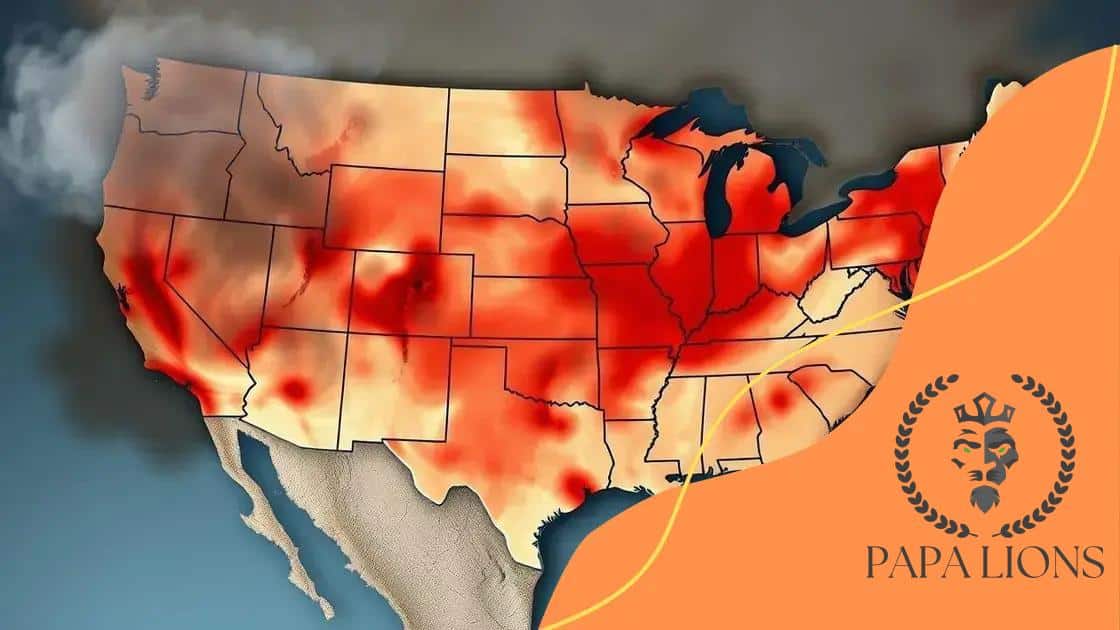Breathing through the haze: Wildfire smoke map across the U.S.

Wildfire smoke poses serious health risks, affecting air quality and respiratory health; staying indoors, using air purifiers, and monitoring air quality can help minimize exposure during smoke events.
Wildfire smoke map across the U.S. has become one of the most important tools for people tracking air quality during fire season. Have you seen the wildfire smoke map across the U.S.?
As wildfires increase, understanding how smoke affects our air quality becomes crucial. Let’s dive into what this means for you.
Understanding wildfire smoke: its impact and dangers
Wildfire smoke is more than just an eyesore; it poses serious health risks. Understanding its impact and dangers is essential for everyone living in affected areas. When wildfires burn, they release smoke that travels far and wide, affecting air quality even in distant locations.
This is why the wildfire smoke map across the U.S. is crucial for awareness. The smoke contains a mix of gases and fine particles which can harm our lungs and overall health.
Beyond the immediate respiratory issues, wildfire smoke can also affect mental well-being by increasing stress levels in communities repeatedly exposed to poor air quality.
Continuous monitoring through the wildfire smoke map across the U.S. helps residents prepare both physically and emotionally for prolonged exposure.
What does wildfire smoke contain?
The composition of wildfire smoke can include a variety of harmful substances.
- Particulate matter: These tiny particles can penetrate deep into the lungs.
- Carbon monoxide: This gas can limit the amount of oxygen in the blood.
- Volatile organic compounds: These can contribute to smog and other respiratory issues.
As the smoke mixes with our air, it can create unhealthy conditions. Those with pre-existing health conditions, children, and the elderly are particularly vulnerable.
It’s important to check the wildfire smoke map across the U.S. to anticipate poor air conditions and be aware of warning signs of smoke exposure, such as coughing, difficulty breathing, and eye irritation.
Researchers continue to study how repeated exposure to these pollutants may increase long-term risks such as cardiovascular disease. With more fires each year, the wildfire smoke map across the U.S. has become an indispensable health resource for both short-term alerts and long-term awareness.
How does smoke affect air quality?
Wildfire smoke lowers air quality indicators, making the air hazardous to breathe. When an area experiences high levels of smoke, it can lead to air quality alerts. The wildfire smoke map across the U.S. is often used to track these alerts in real time.
During these alerts, it’s crucial to limit outdoor activities. Staying indoors with windows closed can help reduce exposure. For some, using air purifiers can improve indoor air quality.
By understanding the nature of wildfire smoke and its dangers, and following updates from the wildfire smoke map across the U.S., communities can better prepare for its impact.
In addition, poor air quality has ripple effects, including lower visibility for drivers and delayed flights. Monitoring updates through the wildfire smoke map across the U.S. ensures that individuals, families, and even businesses can adapt quickly to changing conditions.
How to read the wildfire smoke map
Reading a wildfire smoke map across the U.S. can help you understand how smoke impacts your area. These maps provide important information about air quality and visibility. Understanding the colors and symbols on these maps is crucial for your safety.
By checking these maps regularly, you not only protect your health but also plan daily activities more efficiently. For instance, outdoor workers and athletes rely on the wildfire smoke map across the U.S. to adjust schedules and minimize health risks during heavy smoke days.
Understanding the color codes
Different colors on the map indicate varying levels of smoke pollution.
- Green: Good air quality.
- Yellow: Moderate air quality; some may experience health effects.
- Orange: Unhealthy for sensitive groups; limits outdoor activities.
- Red: Unhealthy air quality; everyone should reduce outdoor exposure.
Familiarizing yourself with these colors helps you make informed decisions. If the wildfire smoke map across the U.S. shows red or orange, it’s best to stay indoors.
In many regions, communities now integrate these color codes into local emergency alert systems, ensuring that residents receive timely warnings. The wildfire smoke map across the U.S. thus acts as both an educational and preventive measure.
Using additional resources
Along with the smoke map, you can access other resources to gauge air quality. Many websites and apps provide updates in real-time. Checking local health department websites can offer specific information tailored to your location.
The wildfire smoke map across the U.S. becomes even more effective when used alongside these resources. These alerts help you stay aware of conditions that may worsen due to wind patterns or increased fire activity. By using the wildfire smoke map across the U.S., you can actively protect your health.
Schools, businesses, and even sports leagues now rely on these combined resources to make decisions about closures and schedule adjustments. This makes the wildfire smoke map across the U.S. a central part of public health planning.

Health tips during wildfire smoke events
During wildfire smoke events, protecting your health is essential. The wildfire smoke map across the U.S. is a helpful tool to know when conditions are dangerous.
Remaining prepared with supplies such as masks and clean water can also help reduce risks. By combining these efforts with updates from the wildfire smoke map across the U.S., you create an effective defense against smoke exposure.
Stay indoors when possible
Limiting your time outdoors is one of the most effective ways to reduce smoke exposure. If possible, stay inside during smoke alerts. Keeping an eye on the wildfire smoke map across the U.S. helps you know when it’s safe to resume activities.
For families, creating a designated “clean room” with air filtration can offer extra protection during heavy smoke days. Knowing when to use this room is easier when following the wildfire smoke map across the U.S. updates.
Use air filters and purifiers
Using air purifiers with HEPA filters can greatly improve indoor air quality. Combined with updates from the wildfire smoke map across the U.S., you can create a safe space in your home during severe smoke conditions.
Communities with limited resources are also setting up public “clean air centers” where residents can gather during hazardous conditions. These centers are typically opened when the wildfire smoke map across the U.S. signals prolonged poor air quality.
Monitor health symptoms
While wildfires continue, pay attention to how you feel. If symptoms like coughing, wheezing, or irritation worsen, consult your doctor. The wildfire smoke map across the U.S. can help you anticipate when these symptoms may flare up.
Keeping medications and protective masks ready ensures you can respond quickly. In fact, doctors often advise patients to watch both their health and the wildfire smoke map across the U.S. simultaneously during fire season.
Recent trends in wildfire activity across the U.S.
Recent trends in wildfire activity across the U.S. have shown alarming increases. Checking the wildfire smoke map across the U.S. is now part of daily life for many communities.
The rise of larger, longer-lasting wildfires means that entire states must prepare for recurring smoke events. The wildfire smoke map across the U.S. provides a nationwide perspective, showing how fires in one state can spread smoke hundreds of miles away.
Wildfire statistics over the years
According to the National Interagency Fire Center, millions of acres burn annually. As these fires grow, the wildfire smoke map across the U.S. has become more vital than ever for tracking spread and smoke.
Looking at these statistics, researchers warn that unless drastic action is taken to address climate change, the numbers will continue to climb. This makes the wildfire smoke map across the U.S. a tool not only for current safety but also for long-term environmental studies.
Factors contributing to wildfires
Climate change and human activity both drive the rise in wildfires. Communities must rely on the wildfire smoke map across the U.S. to prepare and adapt to these realities.
Urban expansion into fire-prone areas has increased the danger for millions of residents. By consulting the wildfire smoke map across the U.S., communities can better understand which regions are at the highest risk and take preventive measures.
Resources for tracking wildfire smoke updates
Accessing reliable resources for tracking smoke is essential. The wildfire smoke map across the U.S. is one of the top resources available.
Local governments and national agencies have invested heavily in improving these tools, recognizing that timely access to smoke information can save lives. The wildfire smoke map across the U.S. is now often featured in weather forecasts alongside temperature and precipitation.
Online air quality monitoring sites
Websites like AIRNow, PurpleAir, and EPA offer live data that complements the wildfire smoke map across the U.S.. These combined tools give you the most accurate picture of air quality.
These platforms are especially valuable for vulnerable groups such as people with asthma, who can use the data to plan their medication schedules. Pairing these updates with the wildfire smoke map across the U.S. ensures even greater safety.
Mobile apps for wildfire updates
Apps like Wildfire Tracker and AQI App work hand in hand with the wildfire smoke map across the U.S. to provide instant updates. Using both ensures you stay informed and safe during wildfire events.
With push notifications, these apps alert users to sudden changes in smoke conditions. Together with the wildfire smoke map across the U.S., they provide a layered system of protection against the dangers of wildfire smoke.
FAQ – Frequently Asked Questions about Wildfire Smoke and Safety
What are the health effects of wildfire smoke?
Wildfire smoke can cause respiratory issues, eye irritation, and exacerbate pre-existing conditions like asthma and heart problems.
How can I track wildfire smoke updates?
You can track updates through online air quality monitoring sites like AIRNow and mobile apps that provide real-time data.
What should I do if smoke levels rise in my area?
Stay indoors, keep windows closed, and use air purifiers if possible. Monitor your symptoms and consult a healthcare provider if needed.
Are there tips for staying safe during wildfire smoke events?
Yes, limit outdoor activities, stay informed about air quality, and ensure good ventilation indoors while using air purifiers.





